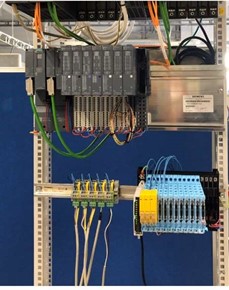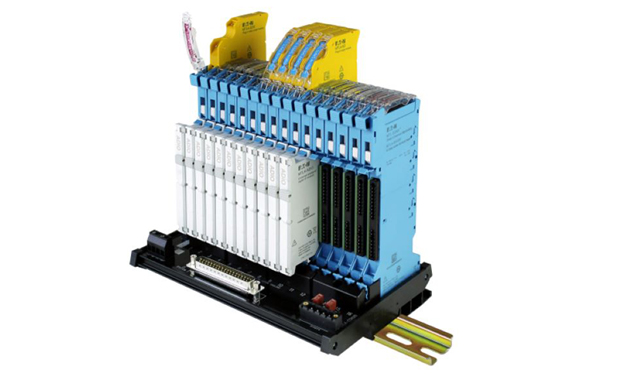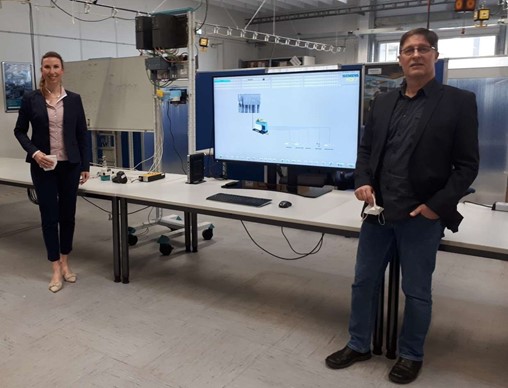- Điện thoại (028) 3811 0510
- Email info@vtltech.com.vn
- Fax (028) 3811 0512
- Liên hệ
Bằng chứng thành công về khả năng tích hợp – SIMATIC ET 200SP HA và MTL SUM5
Vào ngày 30 tháng 3 năm 2021, Trung tâm Đề xuất của bộ phận Giải pháp Tự động hóa Quy trình thuộc Siemens Digital Industries đã chứng minh thành công chức năng của MTL SUM5 – mô-đun đấu nối thông minh đa năng – khi kết nối với dòng thẻ I/O có thể cấu hình mới SIMATIC ET 200SP HA. Nhóm tham gia, gồm các thành viên từ bộ phận Tự động hóa Quy trình của Siemens AG Digital Industries và MTL Instruments GmbH, đều hài lòng vì hệ thống hoạt động hoàn hảo! Bằng chứng khái niệm đã thành công!
Động lực nào thúc đẩy dự án?
MTL Instruments GmbH, một công ty thuộc tập đoàn Eaton, và Siemens AG đang hướng tới mối quan hệ hợp tác lâu dài trong lĩnh vực giải pháp. Khi Hermann Mueller, quản lý đấu thầu tại Trung tâm Đề xuất của Siemens, tham gia vào quá trình ra mắt thị trường của MTL SUM5, ông đã nhận ra ngay tiềm năng kỹ thuật và liên hệ với Marcel Hilger, quản lý khách hàng chính tại MTL Instruments GmbH.
Marcel Hilger đã cung cấp hai mô-đun MTL SUM5 để bắt đầu chuẩn bị. Trước tiên, cần phát triển một sơ đồ đấu nối điển hình vì MTL SUM5 chưa từng được kết nối với SIMATIC ET 200SP HA trước đó. Nhiệm vụ này được giải quyết bởi “Trung tâm Kỹ thuật Toàn cầu” của Siemens tại Ấn Độ. Ngoài ra, môi trường thử nghiệm và các kịch bản kiểm tra cũng được thiết lập. Olaf Schnur từ bộ phận Quản lý Ngành Hóa chất của Siemens Digital Industries đã đảm nhận thử thách này thành công. Khi mọi thứ đã sẵn sàng, tất cả các bên liên quan được mời đến buổi “Bằng chứng khái niệm” để trình diễn toàn bộ chức năng.
Tại sao và để làm gì?
 Trong các nhà máy điều khiển quy trình thuộc ngành hóa chất và các ngành khác, tất cả tín hiệu quy trình như áp suất, nhiệt độ, lưu lượng cũng như tín hiệu điều khiển cho van và động cơ đều được trao đổi thông qua các thẻ I/O từ hệ thống điều khiển quy trình đến các thiết bị ngoại vi. Tùy theo yêu cầu, có thể là tín hiệu nhị phân đầu vào (ví dụ: phản hồi van), tín hiệu nhị phân đầu ra (ví dụ: lệnh bật/tắt) hoặc tín hiệu tương tự đầu vào (ví dụ: đo lưu lượng, áp suất và nhiệt độ).
Trong các nhà máy điều khiển quy trình thuộc ngành hóa chất và các ngành khác, tất cả tín hiệu quy trình như áp suất, nhiệt độ, lưu lượng cũng như tín hiệu điều khiển cho van và động cơ đều được trao đổi thông qua các thẻ I/O từ hệ thống điều khiển quy trình đến các thiết bị ngoại vi. Tùy theo yêu cầu, có thể là tín hiệu nhị phân đầu vào (ví dụ: phản hồi van), tín hiệu nhị phân đầu ra (ví dụ: lệnh bật/tắt) hoặc tín hiệu tương tự đầu vào (ví dụ: đo lưu lượng, áp suất và nhiệt độ).
Những loại tín hiệu này phải được xác định ngay từ đầu khi cấu hình nhà máy và được đấu nối cố định. Việc thay đổi sau này đòi hỏi nhiều công sức. Vì lý do đó, Siemens đã thiết kế dòng thẻ I/O có thể cấu hình mới SIMATIC ET 200SP HA để các loại tín hiệu này có thể được cấu hình linh hoạt.
MTL Instruments GmbH cũng đã làm điều tương tự với mô-đun MTL SUM5 mới của họ. Khi hai thành phần này được kết nối, tất cả các loại tín hiệu đều có thể cấu hình mà không cần thay đổi dây đấu nối trong suốt quá trình vận hành của nhà máy.
Tại sao cần mô-đun MTL SUM5? Tại sao không kết nối trực tiếp với thẻ I/O?
Lý do là để dễ bảo trì hơn và đảm bảo cách ly điện giữa các tín hiệu. Trong trường hợp có sự cố, ví dụ như hỏng cảm biến, vòng tín hiệu cần được ngắt và phân tích mà không ảnh hưởng đến các tín hiệu khác trên cùng thẻ I/O (thường có 16 kênh). Ngoài ra, nếu một tín hiệu bị ngắn mạch thì không được ảnh hưởng đến các tín hiệu khác. Trước đây, yêu cầu này đòi hỏi hệ thống dây phức tạp và nhiều linh kiện như bộ khuếch đại, đầu nối và điốt.
Với MTL SUM5, chỉ cần một mô-đun được kết nối bằng cáp cấu hình sẵn với thẻ I/O ở một đầu và cáp trường kết nối với cảm biến và thiết bị truyền động ở đầu còn lại.
“Điều đó có nghĩa là ngay cả một nhà máy với 10.000 tín hiệu I/O cũng chỉ cần một sơ đồ đấu nối điển hình để xử lý các loại tín hiệu như đầu vào tương tự, đầu vào nhị phân và đầu ra nhị phân,” Marcel Hilger kết luận. “Việc thiết kế chi tiết có thể thực hiện bằng laptop và thay đổi phần mềm không yêu cầu thay đổi dây đấu nối trong tủ điện.”
Lợi ích cho khách hàng là gì?
Đối với khách hàng cuối và người sử dụng, điều này đồng nghĩa với việc giảm diện tích tủ điện và giảm số lượng linh kiện dễ hỏng. Ngoài ra, còn tăng tính linh hoạt khi thay đổi hoặc cải tạo hệ thống.
 MTL Instruments ước tính mức tiết kiệm về không gian và yêu cầu tủ điện có thể lên đến 70%.
MTL Instruments ước tính mức tiết kiệm về không gian và yêu cầu tủ điện có thể lên đến 70%.
Đối với người thiết kế và lập kế hoạch nhà máy, điều này giúp tiết kiệm thời gian và tăng tính linh hoạt, vì không cần xác định chi tiết ngay từ đầu. Do đó, các phụ thuộc khác và thời gian xử lý có thể giảm đáng kể. Câu nói: “Thay đổi sau này sẽ tốn kém hơn” đã không còn đúng nữa!
Lợi ích cho Siemens và MTL Instruments là gì?
Cả hai công ty đều tập trung vào lợi ích của khách hàng. “Khách hàng trong lĩnh vực giải pháp mua sản phẩm của chúng tôi để vận hành sản xuất linh hoạt, hiệu quả, tốt hơn và an toàn hơn,” bà Miriam Stricker, trưởng Trung tâm Đề xuất của bộ phận Giải pháp Tự động hóa Quy trình thuộc Siemens Digital Industries tại Karlsruhe chia sẻ. “...nghĩa là khi họ có lợi ích,” ông Ulrich Künzli, quản lý kinh doanh tại MTL Instruments GmbH bổ sung. Trong trường hợp này, cả hai công ty đã kết hợp sản phẩm mới nhất của mình để tạo ra một giải pháp sáng tạo.

Bên trái: Miriam Stricker, Trưởng Trung tâm Đề xuất thuộc bộ phận Giải pháp Tự động hóa Quy trình tại Siemens Digital Industries, Karlsruhe.
Bên phải: Hermann Mueller, Quản lý đấu thầu của Trung tâm Đề xuất thuộc bộ phận Giải pháp Tự động hóa Quy trình tại Siemens Digital Industries, Karlsruhe. Khu vực thử nghiệm ở phía sau.
Liên hệ:
Miriam Stricker
Siemens AG
Digital Industries
Tự động hóa Quy trình
Trung tâm Đề xuất
DI PA SE&C SO PCE
Email: miriam.stricker@siemens.com
www.siemens.com
Marcel Hilger
Eaton
MTL Instruments GmbH
Crouse-Hinds Division
Email: MarcelHilger@Eaton.com
www.eaton.com



